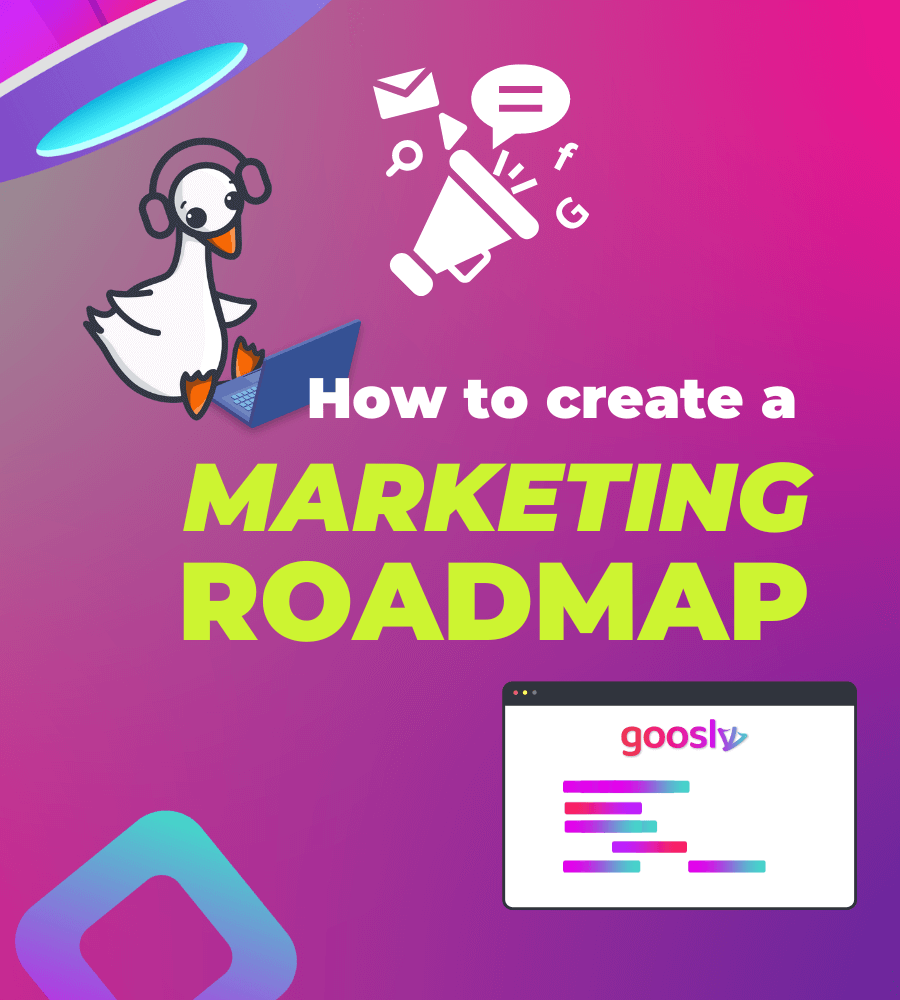What you'll get from this article:
- What is a marketing roadmap, and why should businesses use one
- How can marketing teams create roadmaps
- What are some of the benefits of using marketing roadmaps
- How can marketing roadmaps benefit businesses
- What tools can marketers use to create roadmaps
A roadmap is a plan that outlines the steps a business will take to achieve its marketing goals. Roadmaps can help marketing teams visualize their goals and strategies, and they can also help businesses track their progress and assess their performance. There are many benefits to using marketing roadmaps, and fortunately, there are several tools that marketers can use to create them.
Creating a marketing roadmap is one of the most important things you can do for your business. A roadmap lays out your marketing strategy for the coming year and helps ensure that all of your efforts are aligned and working together towards common goals. This blog post will discuss creating a marketing roadmap with Goosly to help you succeed!
1. Define your business goals
Before you can start planning your marketing roadmap, you need to define your business goals. What do you want to achieve with your marketing efforts? Do you want to increase brand awareness, boost sales, or attract new customers?
Once you have defined your goals, you can start planning the steps you need to take to achieve them. Your marketing roadmap should outline the specific actions you need to take and the deadlines for completing them. It should also include a budget for your marketing efforts so you can stay on track financially.

If you're unsure where to start, there are several online resources that can help. The Small Business Administration (SBA) has a variety of helpful guides on topics such as creating a marketing plan, developing a website, and using social media for marketing. The SBA's website also includes templates and worksheets that you can use to create your own marketing roadmap.
2. Outline your target audience
The next step in creating a successful marketing campaign is understanding your target audience. Who are you trying to reach with your products or services? What do they want or need?
Once you have a clear idea of your target audience, you can develop marketing plans like public roadmaps to reach them. This may include creating marketing materials that speak to their needs and interests or targeting specific channels where they are most likely to be active.

It's also important to understand the buying process of your target audience. What stages of the purchase decision-making process do they go through? What factors influence their decisions? Knowing this information can help you create content and messaging that resonates with them and encourages them to buy from you.
Once you know who you're targeting and what messaging you want to communicate, it's time to choose which marketing channels will be most effective for reaching them. This may vary depending on your business and the products or services you offer.
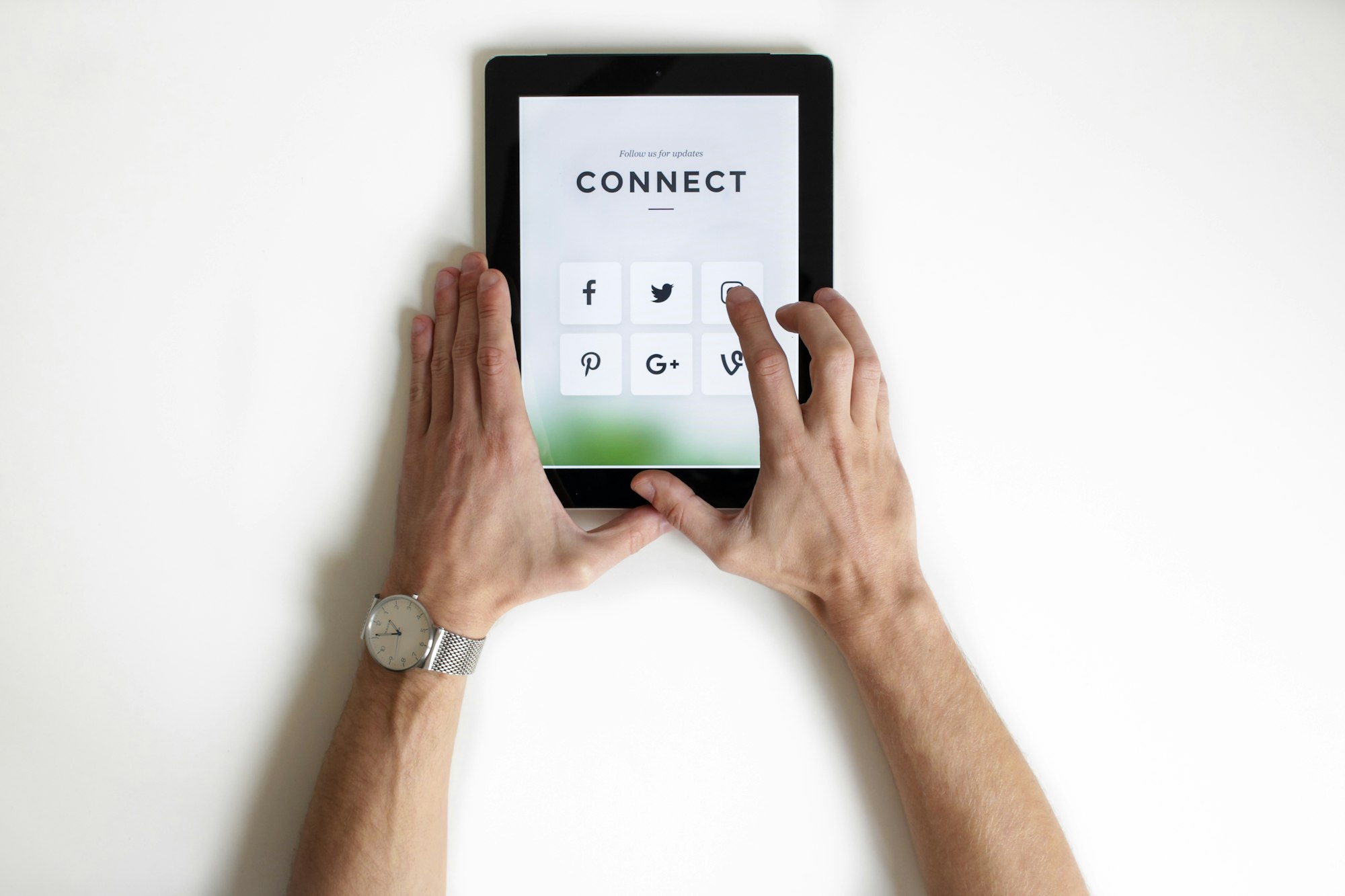
Marketing your startup doesn't have to be expensive. Just creating a Goosly public roadmap is one example of how you can market your company for free. With Goosly, you can create a beautiful, interactive public roadmap that will help you keep track of your progress and impress potential investors and customers.
3. Develop a content strategy
Developing a content marketing strategy may seem daunting, but it doesn't have to be. By following a few simple steps, you can create a content strategy that aligns with your overall marketing roadmap and helps you achieve your business goals.
First, start by understanding your audience. Who are they, and what do they want or need? Once you better understand your target audience, you can begin creating content that resonates with them. This may include blog posts, videos, infographics, or even social media posts.
In addition to creating engaging content, it's also important to establish a regular publishing schedule. This will help ensure that your audience always has something new to consume, and it will also help you track the effectiveness of your content marketing efforts.
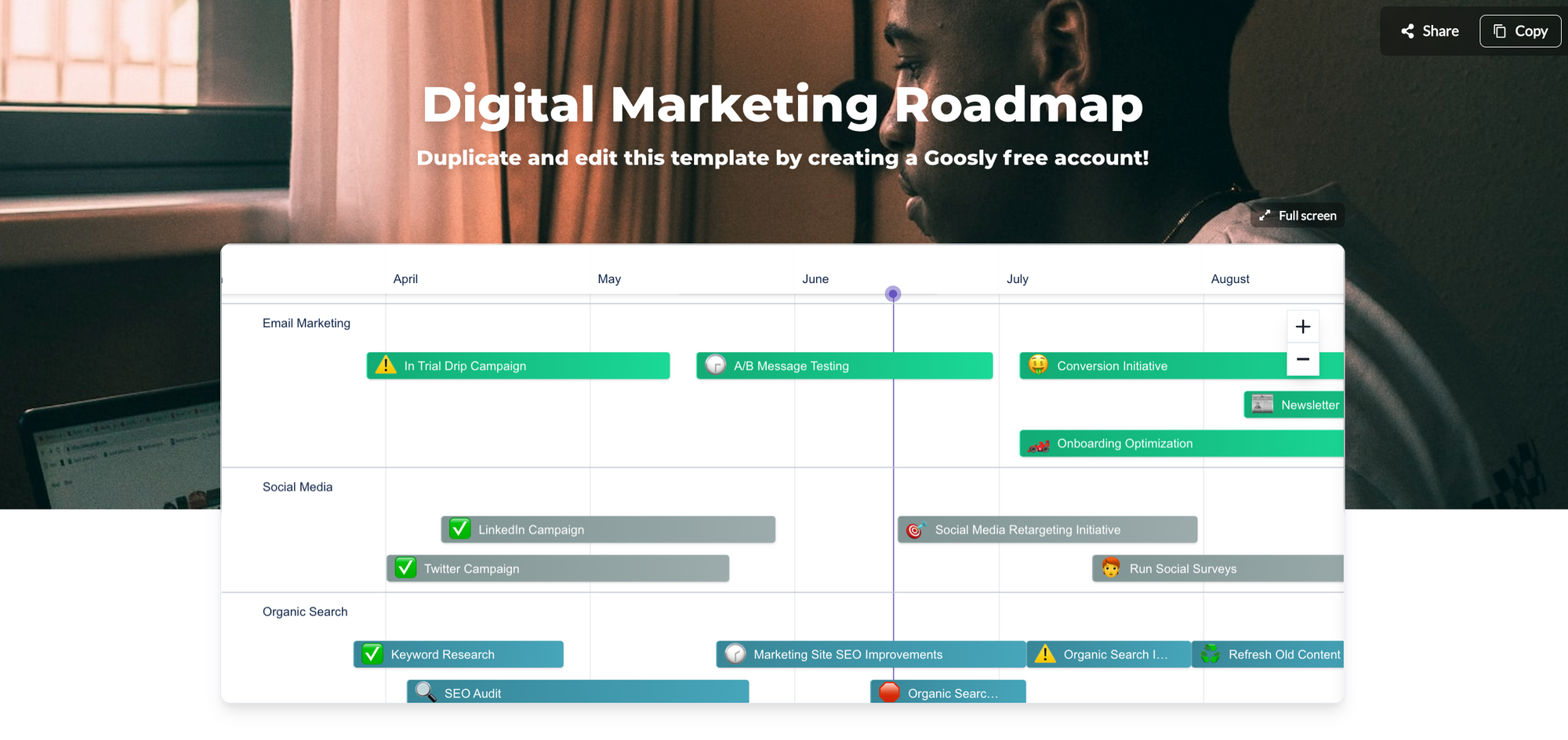
Finally, be sure to measure the success of your content marketing strategy regularly. Use analytics tools to track how much traffic your content generates and how much revenue it's driving. By tracking this data, you can ensure that your content marketing efforts achieve their desired results.
A digital marketing roadmap can help you track your publishing schedule and regular evaluations of your marketing strategy. By creating a roadmap that outlines your goals and objectives, you can ensure that your content marketing efforts are on track and achieving the desired results.

In addition, by regularly tracking the performance of your strategic marketing initiatives, you can make necessary adjustments to ensure that you're getting the most out of your efforts. This data can be collected through various analytics tools, such as Google Analytics or Kissmetrics.

By using a marketing roadmap and regular analytics reporting, you can keep your content marketing strategy on track and ensure that it's helping you achieve your business goals.
4. Create a timeline and budget with your own roadmap
When creating a marketing roadmap, it's important to establish a timeline and budget for your efforts. This will help ensure that your marketing roadmap is realistic and achievable.
To begin, start by estimating how long it will take you to complete all of the tasks on your roadmap. Then, create a budget for how much you plan to spend on marketing efforts in that timeframe. This may include expenses like hiring a marketing consultant or purchasing advertising space.

By establishing a timeline and budget for your marketing roadmap, you can ensure that your efforts are well-funded and achievable. This information can also be helpful when pitching your marketing plans to potential investors or partners.
Goosly is a great tool for tracking tasks and budget timelines. Its interactive public roadmap makes it easy to keep track of your progress, and its built-in analytics tools make it easy to track the effectiveness of your marketing efforts. In addition, Goosly's free marketing roadmaps make it an affordable option for small businesses.
5. Implement and track results with your roadmap tool
Once you have created your marketing roadmap, it's important to implement and track the results of your efforts. This can be done by using various analytics tools, such as Google Analytics or Kissmetrics.
By tracking the performance of your marketing efforts regularly, you can make necessary adjustments to ensure that you're getting the most out of your investment. This data can help you determine whether or not certain marketing channels are effective for reaching your target audience.
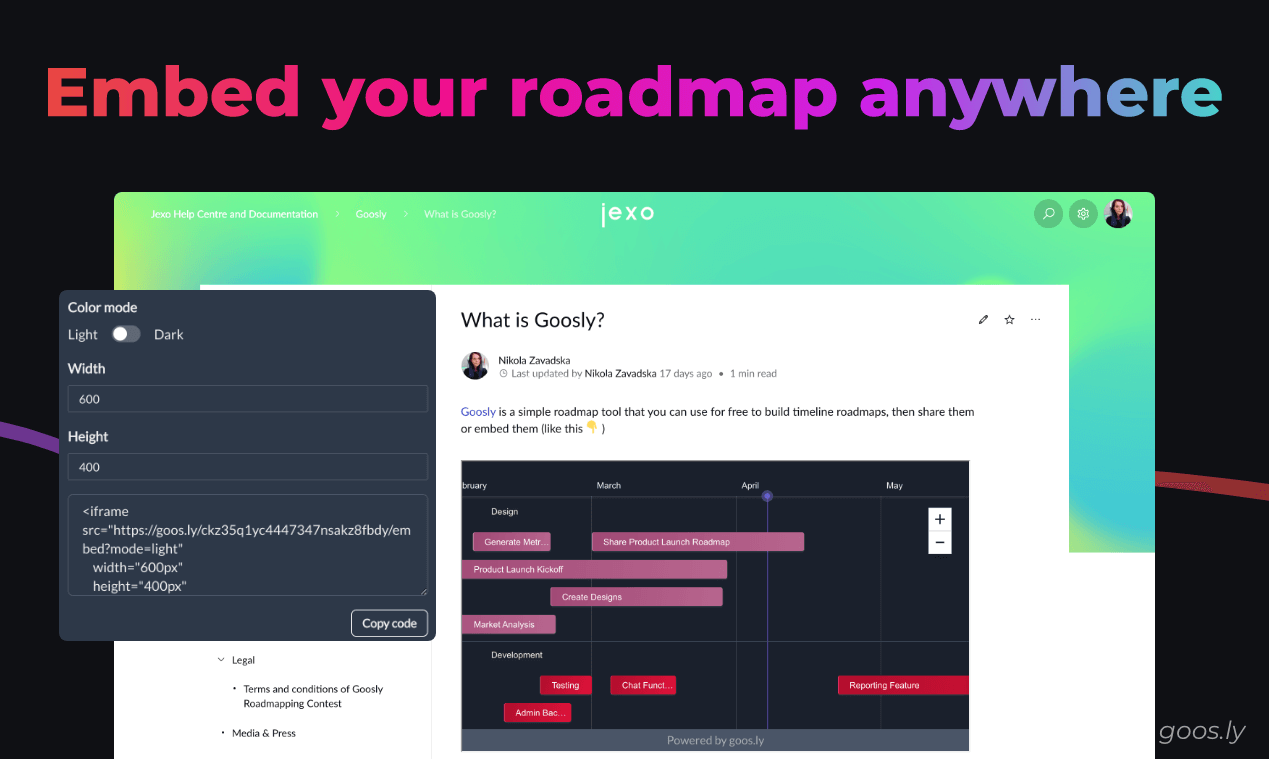
If you are still waiting to see the desired results, feel free to make changes to your project roadmap. The key is to always be flexible and adaptable to continue achieving success with your marketing initiatives.
A marketing roadmap can help you track your progress and measure the effectiveness of your marketing strategy. By using a marketing roadmap and regular analytics reporting, you can keep your marketing campaigns on track and ensure that they're helping you achieve your business goals.
Who is using marketing roadmap templates?
Many businesses use marketing roadmaps as a way to track their progress and measure the effectiveness of their marketing strategy. By using a marketing roadmap and regular analytics reporting, businesses can keep their marketing efforts on track and ensure they achieve their desired results.
In addition, by regularly tracking the performance of their marketing strategy, businesses can make necessary adjustments to ensure that they're getting the most out of their investment. This data can help businesses determine whether or not certain marketing channels are effective for reaching their target audience.

If businesses do not see the desired results, the marketing team can change their marketing roadmap to continue achieving success with their marketing efforts.
Some businesses that create marketing roadmaps include Apple, Google, and Microsoft. These companies update their products and services regularly, and their customers can follow the progress of these updates through the company's public roadmap.
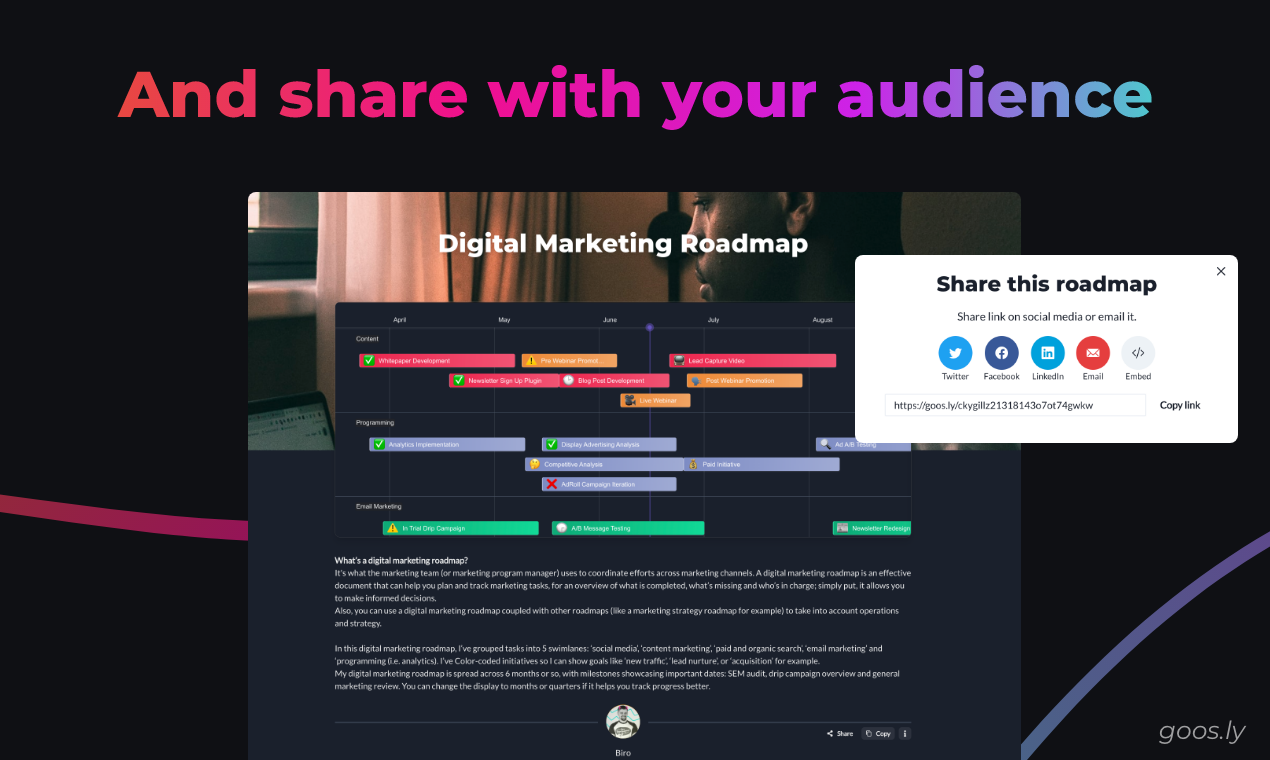
Facebook, Amazon, and Samsung are a few more companies that use marketing roadmaps to track their progress and measure the effectiveness of their marketing strategy. By using marketing roadmaps, these companies can keep their marketing efforts on track and ensure they achieve their desired results. Additionally, by regularly tracking their marketing strategy's performance regularly, these companies can make necessary adjustments to ensure they're getting the most out of their investment.
How can marketing roadmaps benefit businesses?
A marketing roadmap can be an extremely valuable tool for businesses of all sizes. By creating a roadmap, businesses can track their progress and measure the effectiveness of their marketing strategy. This data can help businesses determine whether or not certain marketing channels are effective for reaching their target audience.
This information can also be helpful when pitching your marketing plans to potential investors or partners. By establishing a timeline and budget for your marketing roadmap, you can ensure that your efforts are well-funded and achievable.
How can marketing teams create roadmaps?
There are a number of different tools that marketers can use to create creative and interactive public roadmaps. Some of these tools include:
- Microsoft PowerPoint or Apple Keynote
- Google Sheets or Microsoft Excel
- Goosly
Each of these tools has its own set of strengths and weaknesses, so it's important for marketers to choose the tool that will best fit their needs.
PowerPoint and Keynote are both very versatile tools that allow users to create a wide variety of different types of diagrams. They also both have the ability to embed videos and other multimedia content. However, they can be somewhat limited in terms of the level of interactivity they offer.
Google Sheets and Microsoft Excel are spreadsheet programs that allow users to create complex data visualizations. They also offer a high degree of interactivity and can be easily shared with others online. However, they may be less appealing to some design-savvy individuals.
Goosly is a great tool for creating creative and interactive public roadmaps. Marketers can use Goosly to create maps that show the progress of their projects and track the status of their goals. Additionally, Goosly makes it easy to collaborate with others on projects, share ideas, and get feedback.

In Conclusion
To sum up, public roadmaps are an essential part of any business's marketing strategy. By using a public roadmap, businesses can track their progress and measure the effectiveness of their marketing efforts. This data can help businesses determine whether or not certain marketing channels are effective for reaching their target audience.
If they do not see the desired results, businesses can make changes to their marketing roadmap to continue achieving success with their marketing efforts. Additionally, by regularly tracking the performance of their marketing strategy, businesses can make necessary adjustments to ensure they're getting the most out of their investment.
Marketing roadmaps can also be helpful when pitching your marketing plans to potential investors or partners. By establishing a timeline and budget for your marketing roadmap, you can ensure that your efforts are well-funded and achievable.

Creating a marketing roadmap is a great way for teams to track their progress and measure the effectiveness of their tactics. There are a number of different tools that marketers can use to create creative and interactive public roadmaps. Each tool has its own set of strengths and weaknesses, so it's important to choose the tool that will best fit your needs.
Remember, to create a free public marketing roadmap, you could try Goosly. Goosly is a great tool for creating creative and interactive public roadmaps. Marketers can use Goosly to create maps that show the progress of their projects and track the status of their goals. Additionally, Goosly makes it easy to collaborate with others on projects, share ideas, and get feedback.

